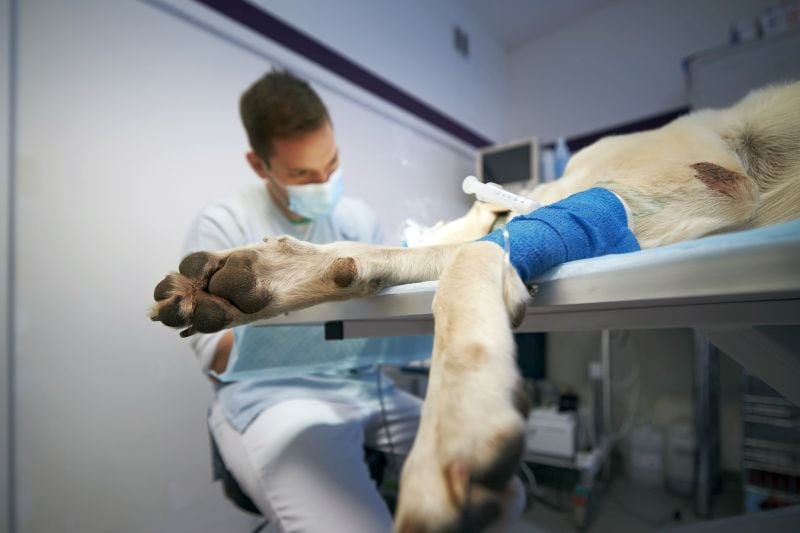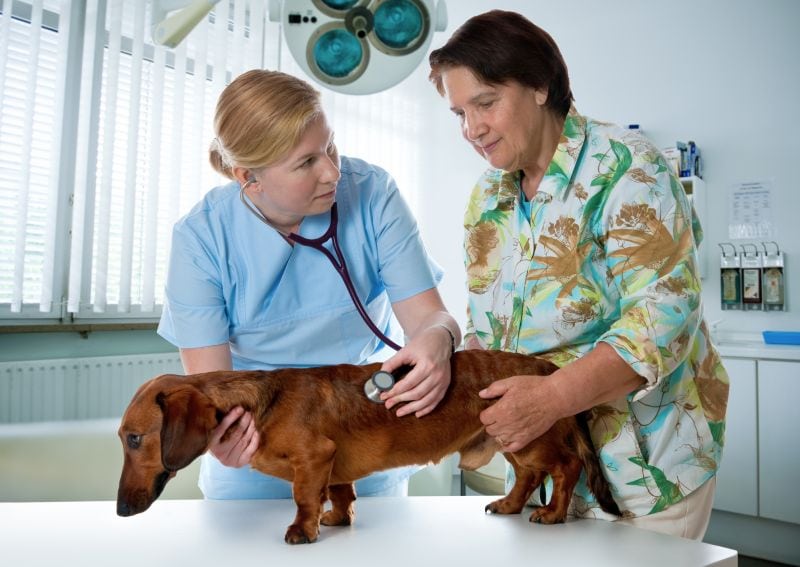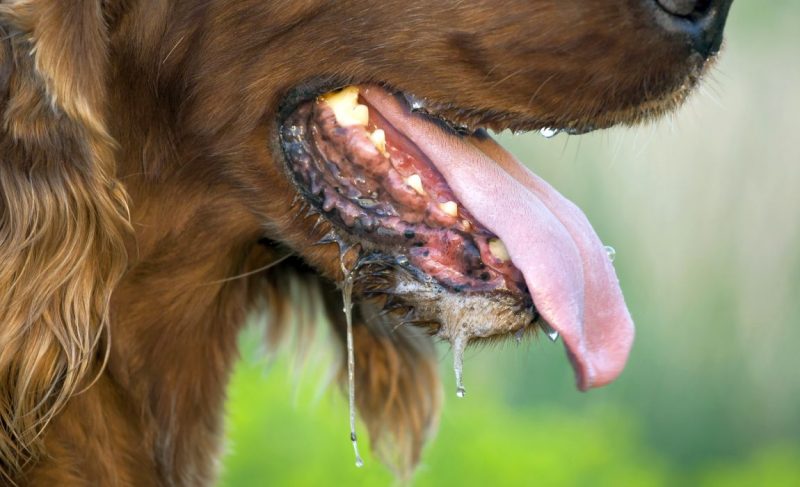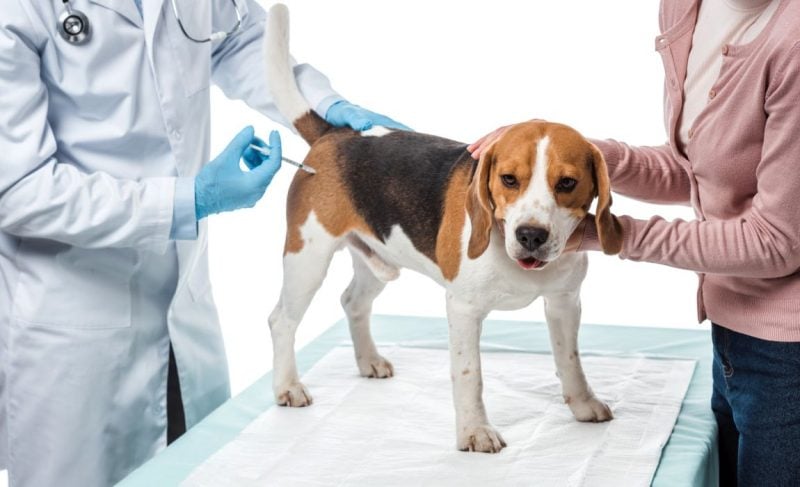Pet health expenses can be overwhelming, from balancing regular wellness care to facing an emergency vet visit for illness or injury.
One way way to mitigate these costs is pet insurance. But with monthly premiums and varying coverage, many owners ask themselves: Is pet insurance worth it?
Like anything, there are benefits of pet insurance as well as drawbacks to consider.
Below, we’ll explain what pet insurance is, share the pros and cons of having pet insurance, and dive into what to look for when shopping for a pet insurance policy for your pup.
Key Takeaways: Is Pet Insurance Worth It
- There are a variety of pet insurance plans on the market that can help defray some of the healthcare costs pet owners face. Some owners opt to purchase these types of plans, while others do not.
- Pet health insurance plans vary widely in terms premium costs, deductibles, and exclusions. These factors help determine whether or not a given insurance plan will make financial sense for your pet.
- Financial arithmetic isn’t the only thing to consider when shopping for pet health insurance plans. You’ll also want to think about things like whether or not your current vet is a member of the insurance network.
What Is Pet Insurance? How Does Pet Insurance Work?

Pet insurance covers a percentage of your dog’s veterinary care costs, with the amount ultimately depending on your policy.
Like car, health, and homeowners insurance, you pay a regular fee (called a premium) and receive reimbursement for covered services after a preset waiting period.
Premiums usually range between $20 and $80 monthly (though some cost more), and they are determined by the following:
- Location: Cost of living in your area affects veterinary care pricing
- Pet’s age: Older pets are more likely to encounter illness, increasing fees
- Breed: Breeds prone to health issues, like brachycephalic pups, cost more to insure
- Plan type: Accident and illness coverage is less expensive than comprehensive wellness plans
- Deductible: The amount you must pay out of pocket before coverage takes over (generally speaking, the higher the deductible, the lower your premium)
- Reimbursement amount: What percentage of costs insurance reimburses after you meet your deductible (typically between 60 and 90 percent)
In most cases, pet insurance requires you to cover vet bills upfront and submit documentation for reimbursement, which isn’t ideal if you don’t have a ton of cash or credit available. This can also be a nightmare if there’s a delay in processing your claim.
That said, having a pet insurance policy means that you’ll usually get some of your money back instead of being on the hook for the entire amount.
However, claims are sometimes denied for a litany of reasons, which can leave you footing the entire bill.
Different Types of Pet Insurance and Coverage

Pet insurance isn’t one-size-fits-all, so it’s essential to know the type of plan that’ll suit you best. . Selecting the correct type of pet insurance with the proper coverage from the start means your sniffer will be set and your wallet protected.
Types of Pet Insurance
Pet insurance types range from emergency-only plans for accidents and illnesses to comprehensive wellness plans covering emergency and routine pet care. Picking the right kind of pet insurance is the difference between having everyday expenses covered and only having emergencies eligible for reimbursement.
Types of pet insurance include:
- Accident-Only: Covers a sudden physical injury to your dog, such as a broken bone, poisoning, laceration, or foreign body obstruction
- Accident + Illness: Covers the accidental injuries listed above as well as illnesses like cancer, vomiting, diarrhea, and urinary tract infections
- Wellness: Covers routine and preventative pet care like annual exams, vaccinations, teeth cleaning, and parasite prevention
- Discount Programs: Not actual pet insurance, offers discounted care in a specific network of vets for an ongoing membership fee (Banfield plans and Pet Assure are popular examples)
Pet Insurance Coverage
Aside from considering the type of insurance you want, be sure to research what the specific plan covers, how much it covers, and when it covers it.
Nothing’s worse than submitting a claim for reimbursement and receiving a big, fat rejection.
Pay close attention to these coverage points with any potential policy:
- Covered care: Most accident and illness plans offer straightforward reimbursement for emergency fees, diagnostics, surgery, hospitalization, and treatment, but always read the fine print to ensure you’re getting all the coverage you need. Similarly, some wellness plans cover dental and spaying/neutering surgery, while others do not.
- Coverage period: Most plans have a waiting period before benefits begin. Generally, this is 14 days for accidents and illnesses and six months or more for hip dysplasia and other major orthopedic conditions. But it can be longer – coverage periods vary significantly from one policy to the next.
- Limits: Policies may cap reimbursement payouts with per-incident, annual, or lifetime limits. Ensure you’re signing up for ample coverage (especially if signing up for a multi-pet plan), as major accidents and illnesses can cost thousands to treat and quickly devour small policy limits.
In some cases, wellness plans also cover alternative health options like acupuncture, spay/neuter surgery, and breeding expenses. But these benefits may require you to upgrade your policy.
Pet insurance typically does not cover dog food (including specialty foods like hypoallergenic diets), cosmetic and elective procedures, boarding and doggy daycare, or over-the-counter vitamins and supplements (like joint supplements or probiotics).
Check out our in-depth review of popular pet insurance companies like HealthyPaws and Trupanion. Here, we break down the particulars of company policies and plan options, plus share some real customer feedback.
The Benefits of Pet Insurance

Pet insurance comes with serious perks, from letting you save your doggy dollars for things other than four-footed emergencies to allowing you to enjoy life without stressing over what may happen to your pup as he plays. Whether you’re looking for comprehensive coverage or a just-in-case policy for accidents, it’s worth considering.
The major benefits of having pet insurance are:
- It saves money on big-ticket vet visits: Annual vet visits can be pricey, but they aren’t even in the same ballpark as injury or illness visits. Costs for CCL surgery stretch into the thousands, for instance. Pet insurance may cover a portion of these costs, sometimes up to 90 percent, depending on your policy.
- Gives you more treatment options: Paying a bill that extends into the thousands isn’t always feasible and, sadly, it often leads to a painful decision no one wants to make. Pet insurance may cover a large portion of these expenses, giving you and your pup more of a fighting chance in whatever your fur kiddo’s facing.
- Provides peace of mind: Accidents and illnesses are an unfortunate part of life for dogs and people alike. You can do everything right and still end up with your pup needing cataract surgery or limping after a day of fun in the sun. Pet insurance may cover these surprise expenses, so you don’t have to stress as much over the what-ifs of woof life.
- Shines a spotlight on your dog’s health: Wellness plans encourage you to get your dog to his annual checkups and often cover preventative care like parasite prevention and dental cleanings. You’re far more likely to use these health-boosting benefits if they’re covered.
- Frees up your savings: Without pet insurance coverage, you’re entirely responsible for your dog’s health care costs, making a rainy-day fund a must. This means regularly setting aside money in case your pup has health issues. With pet insurance offering relief, you can put more money toward fun things, like outdoor adventures with your dog.
- Comes in various options for all budgets: You can select a pricey, comprehensive plan, which will reimburse you for a ton of different services, or you can select a more affordable plan that covers accidents and illnesses only. Many companies also allow you to customize your reimbursement amount or deductible, providing additional savings.
- Offers multi-pet discounts: Vet care for more than one fur friend can be wallet-crushing. However, many pet insurance companies have multi-pet discounts, potentially saving you a pretty penny. Double-check the terms of prospective policies to ensure you get enough coverage for all your pets, as some have low caps on payouts.
The Drawbacks of Pet Insurance

While pet insurance has its perks, it also has notable cons to weigh against them. Knowing these negatives helps you decide what suits your budget and needs best.
Downsides of pet insurance include:
- An added recurring expense: Pet insurance is another bill to add to your monthly or annual expenses. Premiums aren’t always steep (and may potentially pay for themselves), but they add up and may not mesh with your current finances. Premiums may also increase as your dog ages.
- All policies aren’t created equal: Some pet insurance plans only have bare-bones coverage with exemptions galore. If you’re not careful, you may even pay more for the plan premiums than a company winds up reimbursing.
- You must pay up front and wait for reimbursement: Having to pay the initial cost of care through cash or credit and wait for repayment can be nerve-racking or downright impossible, especially if a company is slow at handling claims.
- May not cover pre-existing conditions: Pet insurance seldom covers pre-existing conditions, a name for any documented illness or injury before a policy’s start date. This can quickly become a headache when submitting claims.
- Potential breed restrictions or higher coverage costs: Breeds like Frenchies, bulldogs, and pugs are prone to health issues, and pet insurance companies may charge increased rates or outright refuse coverage. This is also true of certain large-breed dogs prone to cardiac problems like Dobermans.
- Age limits: Pet insurance companies may not cover puppies under eight weeks or refuse coverage for dogs over a certain age, particularly large or giant breeds.
- Not as regulated as other insurances: Pet insurance companies set the industry’s rules, which leaves consumers at risk of changes and restrictions like those against pre-existing conditions and specific breeds.
Some organizations help pay vet bills if you’re in a bind. Some providers also offer discounted care to make expenses more manageable. Unfortunately, they can’t help everyone, but it’s worth looking into if you’re struggling.
Things to Consider When Choosing a Pet Insurance Plan

Browsing pet insurance plans requires serious research to ensure you get the coverage you need, as policies range from minimal accident-only plans to comprehensive coverage. You’ll also encounter policy differences from company to company, including waiting periods, condition restrictions, and more.
Ask the following of any plan before committing:
Can you visit your own vet?
A pet insurance company may (in rare circumstances) require you to select a vet within a network of providers, which may not include your current vet.
This may not be an issue for everyone, but if you’re fond of your pet care provider or wary of vet clinics owned by private firms, this is a major problem.
Does the plan cover preventative visits?
Preventative veterinary care is usually more affordable than treating illness or injury, but it still adds up. You’ll need a wellness or comprehensive plan if you want these services covered by your pet insurance policy.

Can you customize the plan or coverage?
Customizing your policy ensures the best coverage for your pup and budget, but only some companies allow such adjustments.
Others offer set tiers of coverage, limiting your options.
With structured plans, you may have insufficient coverage or unnecessary extras because of price limitations or the inability to pick one “perk” from a higher tier.
Does it cover telehealth (online vet visits)?
Online vet providers like Pawp are an excellent resource for care and guidance during travel or if your pup is anxious during routine visits.
Unfortunately, not all policies reimburse virtual services, so closely examine the details or ask a representative for clarification if you frequent these providers or would like to.
Do you have to pay out of pocket?
Paying for care upfront and waiting on reimbursement is a real bite. Unfortunately, this is the only option with most pet insurance companies.
Having an emergency line of credit via Care Credit can help, but it’s still nerve-racking and something to be aware of.
Are there any breed or age exclusions?
Some pet insurance companies do not cover high-risk breeds like Frenchies and pugs, while others charge steep policy premiums. Pet insurance companies may also refuse coverage until a puppy reaches 8 weeks or for seniors over a specified age.
Are pre-existing conditions covered?
Unfortunately, many pet insurance companies do not cover pre-existing conditions, meaning your dog’s hip dysplasia surgery costs and similar expenses may be denied coverage if issues were documented before signing up. Pre-existing condition worries can be reduced by beginning your dog’s pet insurance policy while he’s still a puppy.
How much does it cost per month?
Pet insurance premium costs vary significantly. Accident-only plans are relatively cheap in case your pup takes a tumble, while a comprehensive policy at a higher price offers coverage for wellness care like routine exams and exams. You must weigh what works best for your budget and coverage needs.
What percentage of your dog’s care is covered?
Pet insurance policies offer different reimbursement levels once you reach your deductible, usually ranging from 60 to 90 percent of costs, though some cover 100! While the lower reimbursement amounts don’t sound like much, they can still offer serious savings if your dog runs up a high veterinary bill.
Is there a deductible?
Most pet insurance policies have a deductible you must meet before reimbursement begins. This can be an annual or per-incident deductible, depending on your plan. Deductibles can be as low as $100 or as high as $1000.
Pet Insurance: Frequently Asked Questions and Concerns

With a million and one technical terms floating around and varying policy coverage levels, pet insurance isn’t the easiest part of #doglife to navigate. Don’t worry; we’ve got you covered with the most commonly asked questions about pet insurance for your pup.
Is pet insurance worth it?
Many times, yes, it is. Pet insurance can save a lot of money in an emergency. Even the most expensive wellness plans can lead to savings, as the average cost of a vet visit isn’t cheap. These expenses quickly add up, particularly with dogs who frequent the vet more than others for exams and care, like seniors and puppies.
Does pet insurance save you money?
Pet insurance can save on expensive care like cancer treatment, broken bones, and illness visits. It’s one of the best ways to save on dog ownership and protect yourself if you have an accident-prone pup.
What are the top pet insurance companies in 2023?
HealthyPaws and Trupanion are two of the most popular pet insurance companies today. Others include Embrace, Pumpkin, and Lemondade. When shopping for plans, don’t just go with what’s popular. Read into every quote to ensure you’re getting the best fit for your dog and needs.
What age is best to get pet insurance?
The sooner, the better. For best results in the long run, it’s best to obtain pet insurance while your dog is still a puppy, especially to avoid as much back-and-forth with your provider about pre-existing conditions.
Should you get pet insurance before getting a pet?
You can’t get insurance until you get a pet, as each policy is customized to your dog’s age and breed. It’ll also inquire about pre-existing conditions–something you can’t answer without a pet yet.
Glossary of Pet Insurance Terms

Pet insurance terminology can feel like another language, making the shopping process confusing. This is especially true as you read the small print of potential plans and uncover more insurance lingo.
Check out these commonly seen terms in pet insurance and their definitions:
- Annual Limit: Maximum amount an insurer will pay per year toward veterinary care
- Bilateral Condition: A health problem that can affect both sides of your dog’s body, like hip dysplasia, cruciate ligament injury, or luxating patella (often, these are considered pre-existing if other limb injury occurred before coverage)
- Chronic Condition: A health issue that is ongoing or incurable, like arthritis, cancer, and hypothyroidism (considered pre-existing if diagnosed before coverage)
- Claim: A request you make for reimbursement of veterinary costs
- Claim Adjuster: An insurance representative who reviews claims to determine if they’re covered by your plan or not
- Continuous Coverage: Coverage that continues between policy periods, preventing a lapse that could leave you financially exposed in a vet emergency
- Co-Payment: A flat fee paid at each appointment in addition to whatever your policy covers (typically only seen in wellness plans)
- Coverage: What services a pet insurance policy reimburses for
- Deductible: The amount you pay for veterinary care before insurance coverage kicks in
- Diagnostics: Tests to diagnose an illness or injury, such as X-rays, bloodwork, or CT scans
- Effective Date: The date that your policy begins covering your pet (generally after a waiting period)
- Elective Procedures: Surgeries or treatments performed for cosmetic or non-medical benefits
- Endorsements: Changes that affect a policy premium’s price
- Enrollment Date: The date that you purchased a pet insurance policy
- Exclusions: Uncovered veterinary treatments
- Explanation of Benefits: A breakdown of each bill explaining what insurance did and did not cover
- Hereditary Disorder: Genetic or inherited health issues passed from parent dogs to puppies; may be covered if a dog doesn’t show clinical signs before policy purchase
- Incident: An accident or illness during a policy’s lifespan
- Limit: The maximum amount your insurance provider will pay out on claims per incident, year, or the lifetime of the policy
- Orthopedic Condition: Health problems of the musculoskeletal system, including bones, muscles, and ligaments (often aren’t covered until after a waiting period)
- Orthopedic Exam: A hands-on check of an animal by a licensed vet to potentially reduce the waiting period placed on orthopedic care
- Pet Health Discount Plans: Policies offering reduced veterinary fees at in-network providers
- Policy Term: Period when your insurance policy is active
- Pre-Existing Conditions: Illnesses or injuries your dog had before the policy came into effect
- Premium: The amount your pet insurance policy costs, paid monthly or annually
- Pre-Paid Health Plan: A plan where you pay a monthly fee that goes toward annual visits, making office visits “free” and offering discounted services
- Preventative Care: Any veterinary care that promotes your pet’s health and wellness, such as vaccines, heartworm prevention, and annual exams
- Primary Diagnosis: Condition causing a dog’s symptoms such as cancer or diabetes
- Primary Diagnostic Testing Maximums: The maximum amount of reimbursement a company will pay for a specific condition, including exams and treatment
- Quote: The estimated amount a policy would cost based on your pet’s age and breed, as well as factors like the annual limit and deductible
- Renewal: Reestablishment of the policy after the term period ends
- Routine Care: Annual exams consisting of a head-to-tail check, flea and tick protection, and vaccines
- Secondary Diagnosis: A condition caused by a primary diagnosis
- Secondary Insurance: A second plan to cover expenses beyond the primary insurance’s limits
- Veterinary Discount Plan: A payment structure where you pay a monthly fee and receive lower treatment costs (and sometimes no office fees!)
- Waiting Period: A time frame before coverage begins after signup, usually 14 days for illness and injury and six or more months for CCL injuries
- Wellness Visits: Routine veterinary trips for annual checkups and vaccinations
Do you have pet insurance for your fur kids? Would you recommend your provider to other pet parents? Share your experiences in the comments. We’d love to hear!












Leave a Comment